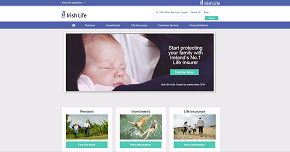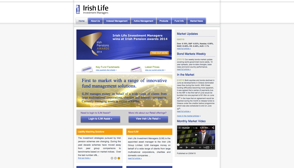You get one chance to get AE right first time
The aim of the Automatic Enrolment (AE) system is to make it easier for employees to save for a pension and boost pension coverage in Ireland. It also makes it easier for employers to offer their employees a workplace pension. The government recently published the latest details around its Auto Enrolment (AE) pensions plans. Employers now need to actively engage and start planning for this new reality. They should,
- Understand how many total employees you have versus the existing pension plan numbers (the gap)
- Consider the pros and cons of having these employees in your established plan versus the new system (ultimately run by the Dept of Social Protection)
- Consider all future new joiners at all levels of the organisation and clarify contract terms and position for them
- Talk to your pension advisor about how to easily make this happen
Contact us AEready@irishlife.ie

Irish Life's Auto Enrolment Comparison 2024
At Irish Life, we have conducted a close examination of the different plans. We believe most employers will have a strong preference for using their existing DC plan as the solution for a few key reasons around flexibility, costs, simplicity and control.
- Significantly better financial incentive in the form of tax relief for all tax payers
- Lower immediate cost to employees due to tax relief on contributions
- Consistent employee rules around retirement ages etc making workforce management easier and more flexible giving employers more control
- Ability to make additional voluntary contributions and wider flexibility around investment fund range
- Proven and tested support systems around advice and information at retirement and other critical times
- See our comparison table
Please talk to your pension advisor who will bring you through all these features or contact us AEready@irishlife.ie
Auto Enrolment FAQs
Here are some FAQs to help employers and those working in the corporate benefit space prepare for AE and how to assess their approach to it for their employees who are not part of their existing scheme but will be eligible for AE.
Auto-enrolment will be run by a new, State-owned, body, the “Central Processing Authority (CPA)”. They are due to be appointed in the first half of 2024. Eligibility Criteria All Private sector workers aged between 23 and 60, with total earnings of more than €20,000 per year, will be automatically enrolled in the new scheme provided they are not already in an existing pension plan. Membership is compulsory for the first 6 months with members then having the opportunity to opt-out. Those who opt-out will be automatically re-enrolled after 2 years. Employees who do not satisfy the age or earnings thresholds will have the right to opt-in to the AE system, if they choose. Contribution Structure Contributions will start at 1.5% of gross salary, from both employee and employer, upon the introduction of AE. They will increase by 1.5% every three years so that after nine years from introduction, employees and employers will both be paying 6% of gross salary. The State will also contribute by way of a top-up payment equal to one-third of the employee contribution. Contributions will be based on a maximum gross salary of €80,000. Investment Strategy The CPA will provide employees with a limited range of investment options including a low to medium risk default fund, which will operate on a lifestyle basis, together with three other fund options, classified as low, medium, and high risk. Administration Charges The CPA is expected to specify the maximum administration and investment management charges that may apply in due course. The government recently published the latest details around its Auto Enrolment (AE) pensions plans. AE has been a long time in development but now looks to have real momentum. It’s time now for employers to actively engage and start planning for this new reality. The government timeline of having AE active by January 2025 is ambitious but must be taken seriously now by all employers. As a reminder, the basis of AE is that all non-pensioned employees will, by default, be placed into a pension once they are over age 23 and under 60 and earn over €20k across all employments. If employers take no action, the relevant employees will be picked up and put into a State-run pension by an organisation called the Central Processing Authority (set up the Dept of Social Protection). This could mean employers will have a mix of employees in different types of pension plans with different rules applying in relation to retirement ages, ability to make top ups, transfers out etc We set out below an outline of some of the differences between long established Defined Contribution (DC) plans and the newly formed State AE model. Employers can take action now to consider their position and, if so desired, bring unpensioned employees into their established plan. The AE system will operate alongside the existing occupational pension system, which may be used as an alternative to auto-enrolling employees in the new State scheme. Auto enrolment won’t be required for employees where pension contributions are already being paid through payroll by those employees, or by the employer on their behalf. So, a key decision for employers will be which of these approaches, the new State AE system or the existing occupational scheme (or Personal Retirement Savings Account), to use for employees who are not currently contributing to a pension plan. This will require an assessment of an employer’s overall people strategy and pros and cons of the different systems. This assessment should take account of the full range of options and supports which may be available to employees in the employer’s plan, in addition to purely financial factors. If the employer wishes to use their existing pension plan to satisfy AE requirements, they will have to consider what changes may be needed to basic plan design to facilitate this approach. For example, changes may be needed to membership and eligibility conditions, to contribution structures, and they may wish to consider whether new employees will join the plan under the same terms, including contribution rates, as existing members or whether different structures will apply to new joiners. At a minimum, employer plans will have to allow immediate membership on commencement of employment, and over time, ensure minimum contribution levels are met for all employees including existing members. The Government has said that initially, on commencement of AE, it won’t be checking contribution levels in existing plans, and once there is a pension contribution paid through payroll from an employee or employer, the employee will be deemed as having pension coverage already and won’t be enrolled in the new State scheme. However, the Government has also indicated that it will engage with the Pensions Authority in the medium term, to develop minimum standards, including contribution requirements, for occupational pension schemes, to allow them to qualify as an alternative to the AE system. They expect to develop these minimum standards once the mandatory contribution levels under AE start to increase. Irrespective of whether an employer chooses to use its existing pension plan or the new State scheme itself to meet AE requirements, the most significant cost is likely to be the employer contribution in respect of all affected current and future employees. A key task which employers should now undertake, if they have not already done so, is to seek to identify all those employees who will or may be affected by AE. This will involve identification of those employees not currently in the employer’s pension plan who meet the AE age and earnings criteria. Employers should be aware that the definition of employee is likely to be broad and include seasonal workers, those on variable hours/earnings, and potentially contract or agency workers etc, though this is unlikely to be confirmed until the legislation is published. Employers also need to understand that employees who do not meet the criteria for automatic inclusion may decide to opt-in to the relevant AE arrangement. Employers need to consider not just the immediate cost upon AE introduction. They also need to be aware that employer contribution costs will increase on a phased based over the first ten years of operation of the AE system, with the employer contribution starting at 1.5% of gross earnings in years one to three, increasing to 3% of gross earnings years four to six, 4.5% from year seven to year nine and rising to 6% of gross earnings from year ten onwards. Employee contributions will also increase like this. Where there may be existing plan members in respect of whom contributions are not being paid in line with these rates, there may be further costs emerging for the employer over the first ten years of AE. Alternatively, some employers may decide to move to the maximum contribution level under the state scheme from the outset. There may also be implementation costs associated with establishing and embedding the new arrangements within an employer’s existing processes. Employers should allow for any such cost as part of their current planning and budgeting for AE, which is strongly encouraged. At Irish Life, we recognise there is unlikely to be one single approach that is appropriate for all employers and all circumstances. Our broad view is that, based on the information currently available, where the employer has an existing occupational pension plan, most employers and most AE eligible employees will find membership of that plan a better overall solution than joining the new State AE scheme. Irish Life is working hard to find an easy solution to facilitate this option for employers. We hope to share more information on this shortly. In the meantime, if you would like to discuss any of these issues further, please get in touch with your usual Irish Life contact or alternatively, please email us at AEready@irishlife.ie









